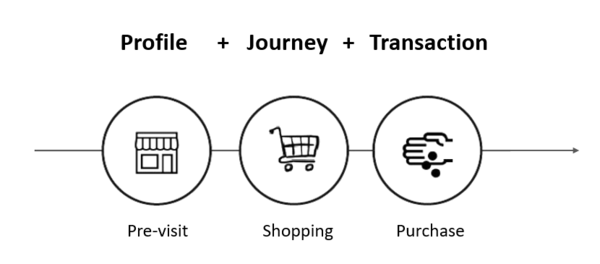S-MALL Overview
Turning Concrete Malls into Smart Malls (S-MALL):
A web-based analytics application for visualizing and mapping in-mall customer journeys and shopping behaviours
Team S-MALL: Chen Yun-Chen | Chiam Zhan Peng | Zheng Bijun
|
|
|
|
|
Contents
ABSTRACT
With growing popularity of e-commerce and online shopping, traditional brick & mortar retail malls are facing stiff challenge and need to reinvent itself and compete with these new “online” channels. As part of the Smart-Nation drive and transformation, retail malls can leverage on this digital transformation journey to find its own unique value proposition with its physical and “offline” presence. With new technologies and connected era like IoT, shoppers are leaving their digital footprints and trackable just like on-line customers.
Retail malls have data such as presence and movement via Wi-Fi access point with customers’ mobile devices, traditional transaction data gathered from daily operations and customers profile data obtained from loyalty programs. The opportunity is to discover patterns and relationship within the data and offer deeper insights, formulate marketing strategies for retail stores and better experience for their customers. This project aims to design and develop a web-based application that provides such analytical visualization. It is developed using open-source R Shiny framework and several R packages such as ggplot2, chorddiag, hexbin, sunburstR, highcharter, arules, visNetwork.
The motivation and objectives will be discussed followed by detailed discussion of the principles, approach and data visualization techniques that are used. Using actual data from a well-known shopping mall, we will demonstrate the functionality of the application in visualizing and discovering the patterns such as peak hour, busy area, movement and customers behavior associated with their profile and transactions. Finally, we will conclude by providing some insights and potential recommendations for their mall operations and strategy.
MOTIVATION
In view of the competitions from online e-commerce channels, there are stronger interests and motivation for key stakeholders in the physical retail malls space to better understand their operations and business so as to provide better value and experience for their customers. We will analyze from a Who, What, Why, How approach to better understand in details and frame the objectives of this project.
WHO – There are 3 key stakeholders involved in the retail shopping mall. They are the mall management, retailers and customers. Mall management are the owner of the mall and are keen to ensure all the rental space are occupied, maximize the rental revenue and able to attract customers to visit the mall on regularly basis. For the retailers, they are keen to know the amount, pattern of footfall and profile of customers that visits their store to better optimize their operating and marketing campaigns. For customers, they would like to have better personalized service which will enhance their shopping experience.
WHAT – This focuses on the key problems and current issues. Even with abundance of data or data accessibility, they are not used effectively. There is no visibility of the footfall, traffic density or journey movement of the customers. The limited mall space is not designed to be best used and rental rate are based on qualitative estimates rather than quantitative parameter to differentiate their rental rates. There are poor insights of customers profile, dwell duration and transactions and this stops the mall and retailers from providing better or differentiate and personalized experience for the customers.
WHY – This focuses on the reason on why it matters. Understanding traffic intensity and flow, dwell duration helps understand the patterns of the customers. Rental rates can be based on facts of footfall patterns and trends rather than fixed based on floor or better location. Linking the movement with the profile and transactions of customers allows for customer segmentation with targeted marketing campaigns. HOW – This will identify on what is required to support the key usage scenarios for the key stakeholders. The area density, inter-floor movement will be the first key business objective followed by the journey, duration and profile associated with it. This will support retail management and retailers to better optimize their operations and marketing campaigns and activities. Association rules analysis will further allow link and drill down into transaction behavior, product-mix and market-basket analysis.
PRINCIPLE & METHODOLOGY
Key objectives |
DATA DESCRIPTION
Data Preparation Tasks
R Packages for Data Preparation
tidyverse, dplyr, data.table, lubridate, tidyr, jpeg, reshape2



